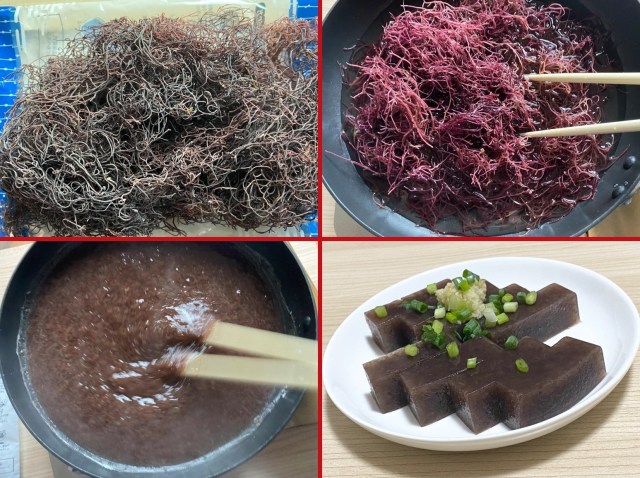
A taste of Tottori that looks very different at the start from how it ends up.
When one hears the term “Japanese food,” a couple of dishes immediately spring to mind, like sushi, ramen, and tempura. But each region of Japan also has its own local specialties, and some of these aren’t even known to people living in just the next prefecture over.
For example, our Japanese-language reporter Ikuna Kamezawa was recently talking about igisu, a specialty of her home prefecture of Tottori, in western Japan…and none of us had any idea what it was, not even Mr. Sato, who grew up in Shimane Prefecture, Tottori’s direct neighbor to the west.
So to get in touch with her roots once again, Ikuna decided to whip up a batch, and to also show us just what the heck igisu is. There’s really only one essential ingredient: igisuso, a kind of red algae also known as ceramium rubrum.
Since igisu is a dish specific to Tottori (and particularly central Tottori, not the east or west parts of the prefecture), you can’t just wander into any grocery store and buy igisuso. However, you can order dried versions online from Rakuten here, and once Ikuna had her bag, it was time to get to work.
Opening the package, Ikuna was greeted by a strong saltwater smell. The first thing to do is to wash the igisuso in water and rinse it thoroughly, picking out any other sea grass bits that you might find.
As Ikuna did this, she thought back to her childhood memories of her grandma making igisu for family dinners, since the dish is especially popular with older generations.
Once the igisuso has been washed and rinsed, place it in a pot with water (540 milliliters [18.3 ounces] of water for 40 grams [1.4 ounces] of igisuso), bring the water to a boil, and let it cook on medium heat. As the igisuso starts to cook, you’ll see it change color from reddish purple to brown.
Don’t walk away, either, because you’re supposed to knead the igisuso. As it cooks, the strands will gradually melt, merging with the water and forming a thick, sticky consistency that you turn and fold onto itself using cooking chopsticks or some other cooking utensil.
Exactly how long to cook the igisuso seems to be a matter of personal taste, and Ikuna can recall her grandma often mentioning, “Today I did a really good job kneading the igisuso” or apologizing for not kneading it quite enough. The packaging for Ikuna’s dried igisuso said to let it boil for 10 to 15 minutes, and she decided to give it the full 15.
But it’s not time to eat right when you turn off the heat. That’s because igisuso is similar to agar-agar and will form into a gelatinous state without any extra hardening agents.
It does need time and a low temperature to do this, though, so after pouring it into a container, Ikuna stuck it in the fridge to chill.
She checked back two hours later, and sure enough, she now had a solid block of igisu!
Like most traditional Japanese foods, igisu is meant to be eaten with chopsticks, so Ikuna sliced it into bite-sized morsels.
Different households use different seasonings, with miso paste and salad dressing being just two options. Ikuna decided to go with grated ginger, sliced green onions, and a dash of soy sauce, just like Grandma used to make.
▼ Igisu is a side dish, but for this meal, it felt like the star of the show to Ikuna.
So how does it taste? Actually, not like very much on its own. Igisu has a very mild flavor, with a slight sensation of marine saltiness. But for Ikuna, who grew up regularly eating this dish that’s largely unknown to the rest of Japan, it was a comforting, nostalgic trip down memory lane for her palate, one that led all the way back to Tottori and a seat at the dinner table with Grandma.
Photos ©SoraNews24
● Want to hear about SoraNews24’s latest articles as soon as they’re published? Follow us on Facebook and Twitter!
[ Read in Japanese ]